Joaquin Murieta. The Spirit of Sonora and the "Mexican Robin Hood"
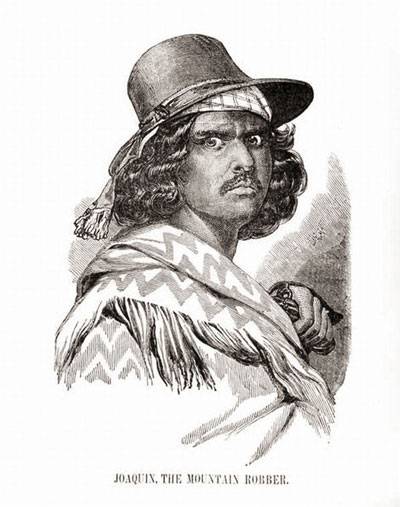
Image of Joaquin Murieta by Thomas Armstrong, 1853
В previous article was told about the California Gold Rush of 1848-1855. and the appearance of the most famous "noble robber" of those places - Joaquin Murieta. He became a national hero in several Latin American countries, moreover, by the beginning of the XNUMXth century, he was considered a revolutionary and a fighter for justice, even in American California. Today we will continue this story, talk about the robbery exploits of the "ataman" Murieta, loud posthumous fame and the "second life" that he found on the pages of books and movie screens.
"Noble Rogue"?
As we remember from the previous article, Joaquin Murieta was not a Chilean, but a Mexican, and he began his career as a robber in September 1851, when he joined a gang organized by his wife's brother, Claudio Felis. According to a widespread version, this happened after the death of his wife, who was raped by a gang of Anglo-Saxon miners. Later, he organized his own "brigade", which was often called the "gang of five Joaquins" - since this name, in addition to Murieta himself, was borne by 4 more members of this band of robbers. We also remember that Joaquin did not offend his compatriots, which is why he got the halo of a “noble robber”, even a defender of the Mexicans from the “gringo”, who only takes away from the “occupiers” what should rightfully belong to the Mexicans (although even more than the whites got from him to the Chinese).
Murieta was lucky, and it is believed that the booty of his gang was a very large amount of 100 thousand dollars at that time, which approximately corresponds to 2 modern dollars. The victims of the bandits were 380 Chinese and 000 "gringos", some authors say that three of those killed were sheriffs. Three ranger detachments, which were created specifically to fight the "gang of five Joaquins", also suffered losses. In addition, the people of Murieta stole over a hundred horses, which they resold in Mexico, and horse stealing was then more than reprehensible. In the already cited first article O. Henry's story "The Vile Deceiver" says this about the kidnapping of the horse by the protagonist:
In the end, a reward of 10 thousand dollars was announced for Murieta's head, and in early May 1853, California Governor John Bigler instructed Captain Harry Love to form a new detachment of rangers from veterans of the Mexican-American War - 20 people with a good salary of $ 150 a month .
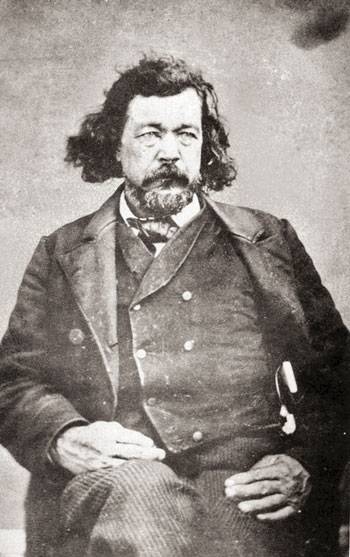
Captain Harry Love
The contract was concluded for three months. For additional incentives, a bonus of $1000 from the authorities was appointed for each murdered member of the "gang of five Joaquins", and the Chinese diaspora promised to add the same amount. And Captain Howard, the owner of one of the large surrounding ranches, singled out the best horses.
I must say that Lava's subordinates themselves were by no means "good boys", at least two of them were murderers: one shot the head of the expedition in which he took part, the other - the waiter.
The end of the "gang of five Joaquins"
Only at the end of the term, on July 25, 1853, Captain Love's rangers attacked Murieta's trail: they met Indians who told about suspicious Mexicans who bought food from them. Murieta's detachment was overtaken near Arroyo de Cantua - on the edge of the Diablo mountain range (modern Santa Clara County, California). In a short fight, two people were killed, three were captured. These captives (as well as 17 other people familiar with the “noble robber”) confirmed that one of the dead was Joaquin Murieta, the second was Manuel Garcia (“Three-fingered Jack”). Murieta's head and Three-Finger Jack's hand were placed in alcohol and delivered to the governor, who paid the Rangers $5. There were rumors among the people that instead of Murieta, Joaquin Valenzuela was killed, especially since other bandits covered themselves with the name of Murieta for a long time, and one of his nephews named Procopio acted in California in the 1860-1870s, declaring that he wants to surpass the glory of his famous relative. However, at that time, robberies in California had practically ceased.
Harry Love tried to cash in on showing the head of Joaquin Murieta and the severed hand of Three-Fingered Jack. He traveled to California cities, and at first his "exhibition" was a success.
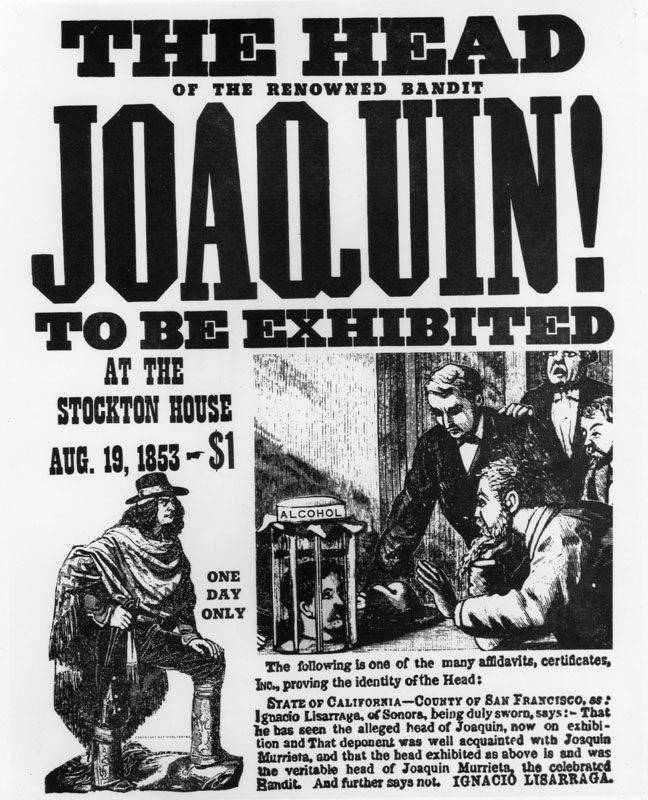
Announcement inviting to see the head of Joaquin Murieta (entrance cost one dollar)
In 1856, the captain sold his “trophies”, which ended up in the San Francisco Pacific Museum in 1881, where they burned down during the 1906 earthquake.
Birth of a legend
Murieta's robbery career lasted less than two years, but even during this time he managed to become so famous that already in 1854 the Indian John Rollin Ridge, who, according to some sources, was the son of the leader of his tribe, wrote and published the book "The Life and Adventures of Joaquin Murieta: A Notorious California Bandit. This book sold a very solid circulation of 7 thousand copies at that time, but Ridge did not receive money for it - he was deceived by the publisher. However, he entered history as the first Native American writer. It was Ridge who laid the foundations of the legend, which told about dubious, from the point of view of serious researchers, episodes of abuse of the hero’s wife, which ended in her death, the hanging of Joaquin’s brother and Rosita’s brother, who were unreasonably accused of stealing horses, as well as the mockery of Joaquin himself who was tied to a tree and whipped. Here is how this episode looks like in the American film "Robin Hood of Eldorado" (1936):
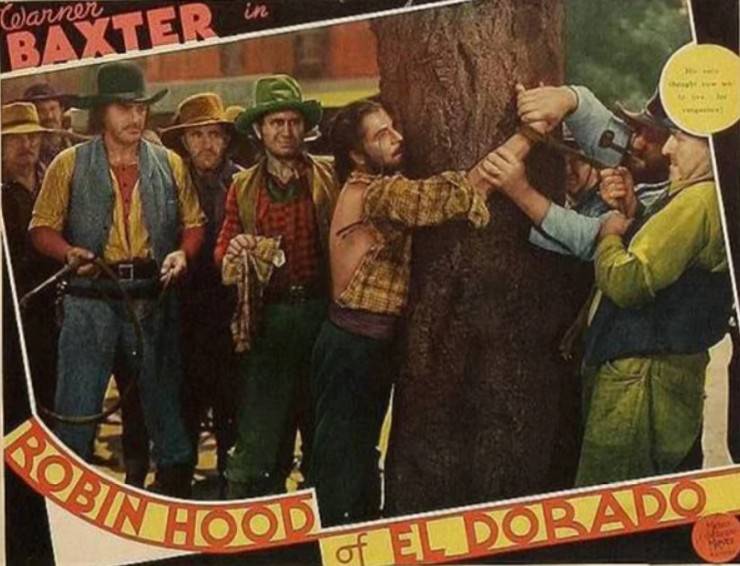
Murieta's further robbery activities, of course, were presented as the hero's noble revenge on the gringo scoundrels. What's more, according to Ridge, Murieta nearly started a full-blown Mexican uprising in California. The book was a success, and very soon other works on the subject began to appear. In some of them, the Mexican Murieta became a Chilean born in the city of Quilleta. His wife was called Carmela, Bellora or Teresa, and in the poem "California" the Aztec emperor Montezuma was declared her ancestor. Joaquin began to be called the Mexican Robin Hood, the Spirit (or Ghost) of Sonora, and even the Robber Napoleon. In general, by 1870, Joaquin had become a national hero in several Latin American countries, and at the beginning of the 1969th century, Murieta was considered a revolutionary and a fighter for justice already in American California. Serious American historians began to write about him, for example, Hubert Bancroft and Theodore Hittell. Based on their "scientific" works, subsequent historians further strengthened the image of the brave fighter for the freedom of compatriots Joaquin Murieta. Things got to the point that some residents of California began to proudly tell that it was their house (or the ranch of their ancestors) that the “noble robber Joaquin” once robbed. Currently, every year on the last weekend of July, "pilgrims" on foot through the mountains and the desert cross the California Valley - to the city of Arroyo de Cantua, in the vicinity of which Joaquin Murieta was killed. At the end of the 1971th century, Murieta's name was given to the Research Center of the University of California at Chicano, founded in 1967, which studies ethnic and racial communities. This story attracted the attention of Pablo Neruda, the Nobel laureate in literature in 23, who, as we remember, wrote the “dramatic cantata” in 1853 “The Radiance and Death of Joaquin Murieta, a Chilean brigand, vilely murdered in California on July XNUMX, XNUMX.” Pay attention: vilely killed, it turns out, the robber, and not his victims.
The romanticized image of Murieta had a huge influence on the formation of another legend - about Zorro (Don Diego dela Vega). The "literary father" of this character was Johnston McCully, who in 1919 wrote the first story - "The Curse of Capistrano". In total, he wrote more than 60 works on this topic. McCully directly said that he was inspired by the story of the robber Murieta. And already in 1920, the first film about Zorro was shot.
The second life of Joaquin Murrieta
But Murieta himself was not deprived of the attention of filmmakers. Among others, the following films were filmed in different countries: "Robin Hood from Eldorado" (1936, American studio Metro-Goldwyn-Mayer), "Bandit Queen" (1950, USA), "The Last Rebel" (1958 ., Mexico), "Pyro" (1962, USA), "Murieta" (1965, Spain), "Under the Mask of Zorro" (1965, Italy), "Desperate Mission" (1969, USA ), the series "Head of Joaquin Murieta" (2023).
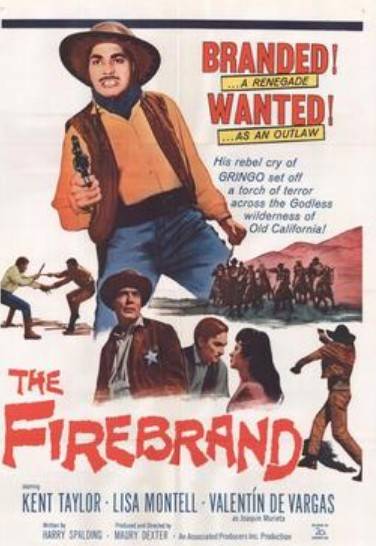
Poster for the movie Pyro, USA, 1962
In addition, separate chapters of the TV series California Bandits (1951), Stories of the Century (1954) and Big Valley (1967) were dedicated to Murieta.
In 1998, the film The Mask of Zorro, shot in the United States, was released, one of the heroes of which was Joaquin Murieta: with a budget of $ 95 million, it grossed more than 250 million at the box office. The main role of Alejandro Murieta (the fictional brother of Joaquin) was played by Antonio Banderas: under the guise of Zorro, he avenges his brother and kills the same Captain Love, who saved California from the raids of the Murieta gang (in the film he is not called Harry, but Harrison).
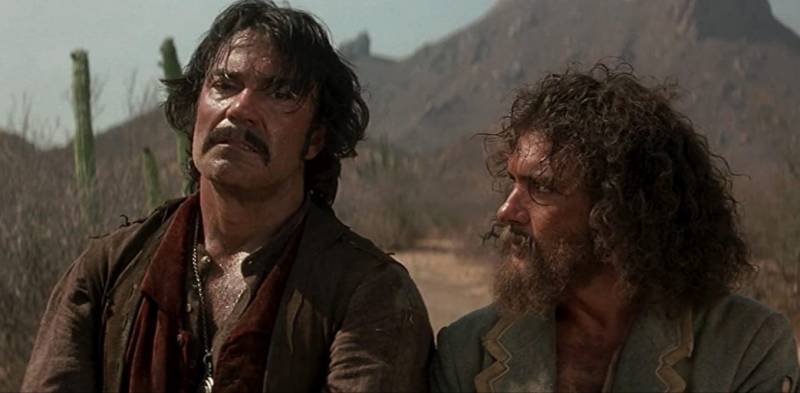
Joaquin Murieta and his brother Alejandro in The Mask of Zorro
In 2005, the documentary "Behind the Mask of Zorro" (History Channel) was released, which talked about Joaquin Murieta and the film "The Mask of Zorro".
From a reality that was not very attractive and did not at all smell of perfumes and flowers, Joaquin Murieta stepped into a beautiful legend. And now it doesn't matter who he really was. In the minds of hundreds of millions of people, Murieta will forever remain a “noble avenger”, standing on a par with such characters as Robin Hood, Rob Roy (Robert McGregor), the corsair Henry Morgan, a rebel, a “sorcerer” and the hero of numerous “tales” and folk songs Stenka Razin (whom A. S. Pushkin called "the only poetic person in Russian history"). But Jeanne d'Arc's colleague Gilles de Rais was not lucky: he was supposed to get into a heroic poem, but ended up in a terrible children's fairy tale in the role of Duke Bluebeard.
Adventures of Joaquin Murieta in the USSR and post-Soviet Russia
But let's get back to Joaquin Murieta, who became widely known in our country thanks to the rock opera by Alexei Rybnikov, written on the basis of the poem by Pavel Grushko (and its source was Pablo Neruda's "dramatic cantata"). For the first time, the opera The Star and Death of Joaquin Murieta was staged in May 1976 on the stage of the Moscow Lenin Komsomol Theater, the main role went to the young Alexander Abdulov. It is interesting that the performance was conceived only as a "staging in the foyer", but after the "deafening" success of the first shows, it was transferred to the big stage. With constant success, this performance at Lenkom went on for 17 seasons.
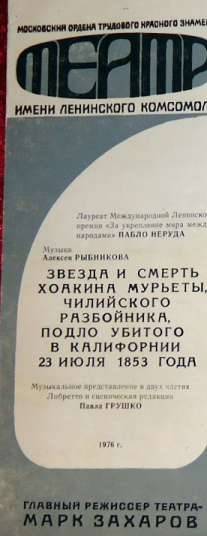
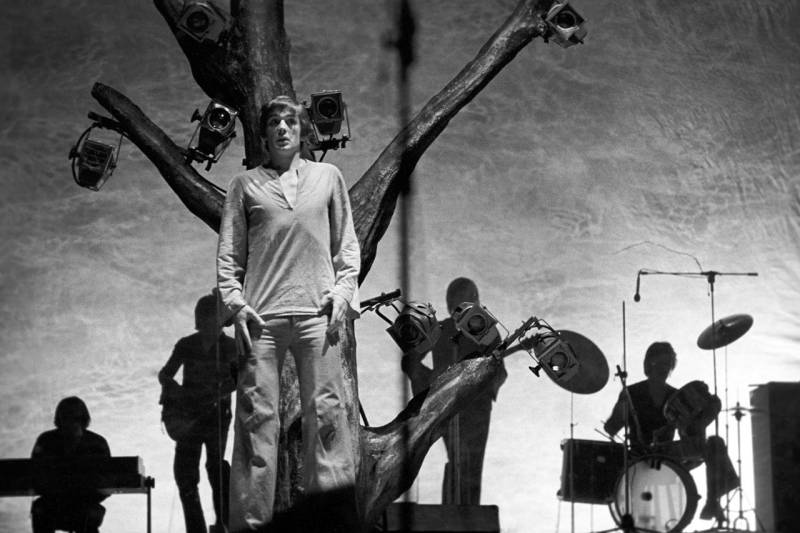
A. Abdulov as Murieta
In 1978, the double album "Star and Death of Joaquin Murieta" took 1st place in the charts of the best records, and in 1979 Alexei Lvovich was recognized as the most popular composer of the year. The part of Teresa was entrusted to Zhanna Rozhdestvenskaya with a unique voice with a range of 4 octaves. Joaquin (as well as Death) was sung by Gennady Trofimov, who is sometimes called one of the most underrated vocalists of the Soviet Union - he could sing arias as a bass profundo, lyric baritone and dramatic tenor. On the recommendation of Alexei Rybnikov, he was accepted into the Moscow Lenin Komsomol Theater, where, in addition to participating in performances, he "staged" the voice of A. Abdulov, N. Karachentsev and E. Shanina.

G. Trofimov, A. Rybnikov, J. Rozhdestvenskaya
New editions of this disc were produced almost every year by the Aprelevsk, Leningrad, Riga and Tashkent phonograph records factories until 1991.
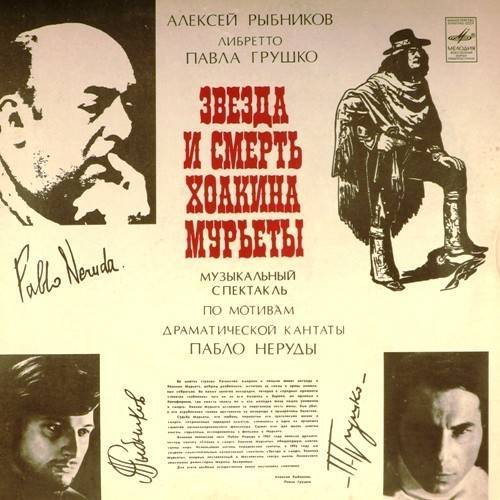
"The Star and Death of Joaquin Murieta", CD 1978
Finally, in 1982, the film of the same name by Vladimir Grammatikov was released on cinema screens. Alexei Rybnikov did not like this picture, and he did not even allow him to put his name among the authors of the script.
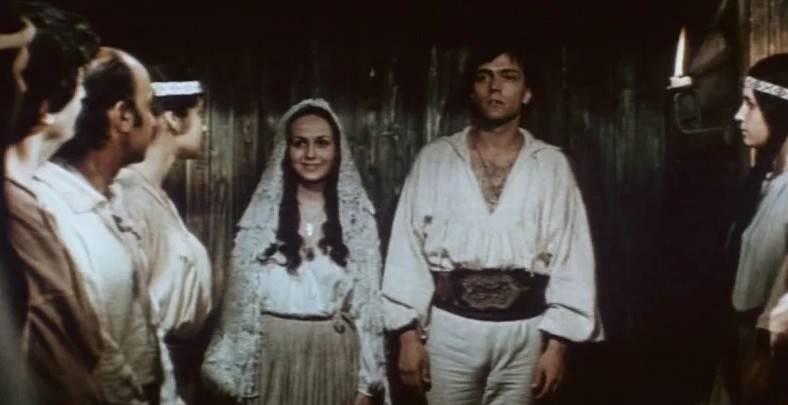
Joaquin and Teresa (A. Kharitonov and A. Belyak) in the Soviet film "The Star and Death of Joaquin Murieta"
It is curious that in the roles of Anglo-Saxon bandits, the audience saw the famous rock musician I. Sandler, the keyboardist of the Integral group, and the singer and composer Y. Loza, even more famous in those years.
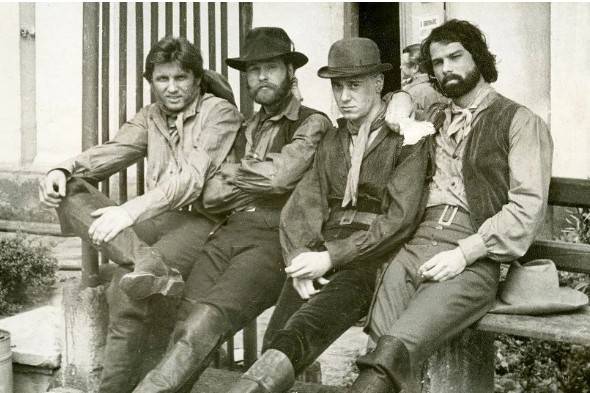
Y. Loza (first from left) and I. Sandler (third from left) in the film "The Star and Death of Joaquin Murieta"
The film of the Yalta branch of the Gorky Central Film Studio for Children (!) and Youth Films turned out to be not hard and even cruel in the Soviet way. Some even spoke of "savoring the scenes of violence."
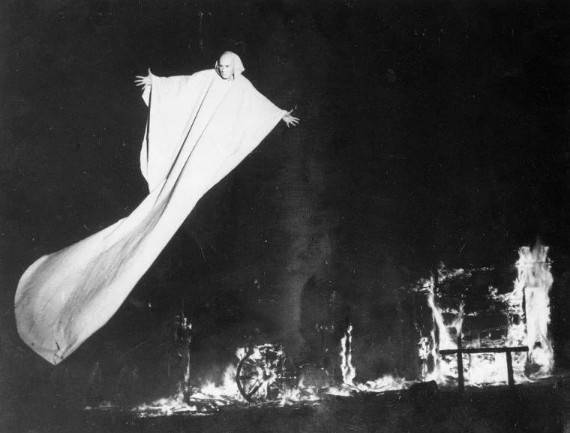
“The public loves when blood is gushing from the screen” (A. Filippenko as Death)
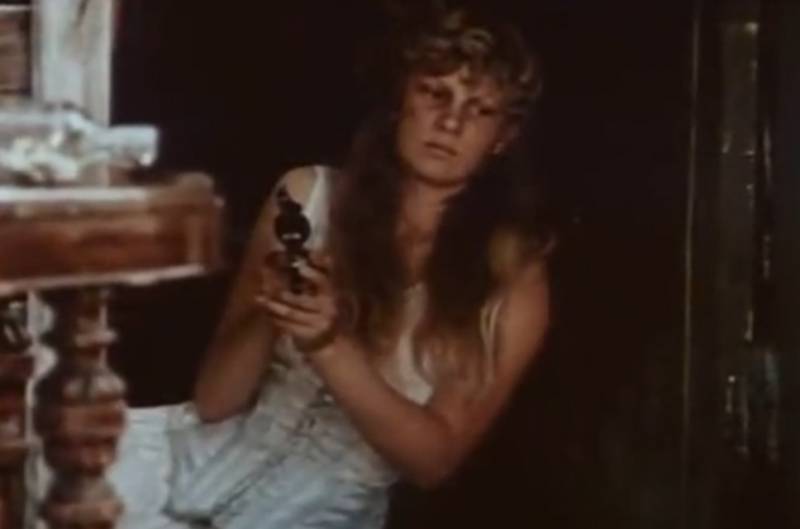
Frame of the film "The Star and Death of Joaquin Murieta": the wife of one of the gringos, who had just killed two Chileans who raped her in front of her husband
But the libretto was written according to the "dramatic cantata" of the communist Pablo Neruda. And another Chilean communist, the famous singer and composer Victor Jara, who was killed during the coup d'état on September 11, 1973, wrote the song "Cueca de Joaquín Murieta":
The purpose of my life is to protect our people.
Long live Joaquin Murieta,
His wild hands, his vengeful eyes.
As well as the song "Asícomo hoy matan negros" ("And today they kill blacks"), which he performed with the group banned by Pinochet Inti-Illimani ("Illimani Sun"). It contained these lines:
They used to be Mexican.
This is how Chileans are killed
Who argues with them about the land
And who in the forehead challenges them ...
He's a Chilean bandit
This is our Joaquin Murieta.
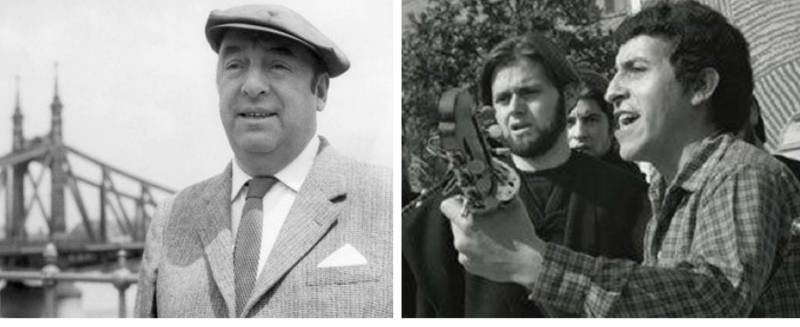
Pablo Neruda and Victor Jara
But it was the Inti-Illimani group that became famous throughout the world with the famous song Venceremos, the alternative and which became the canonical text of which was written by Victor Khara in 1970. And about which Salvador Allende said:
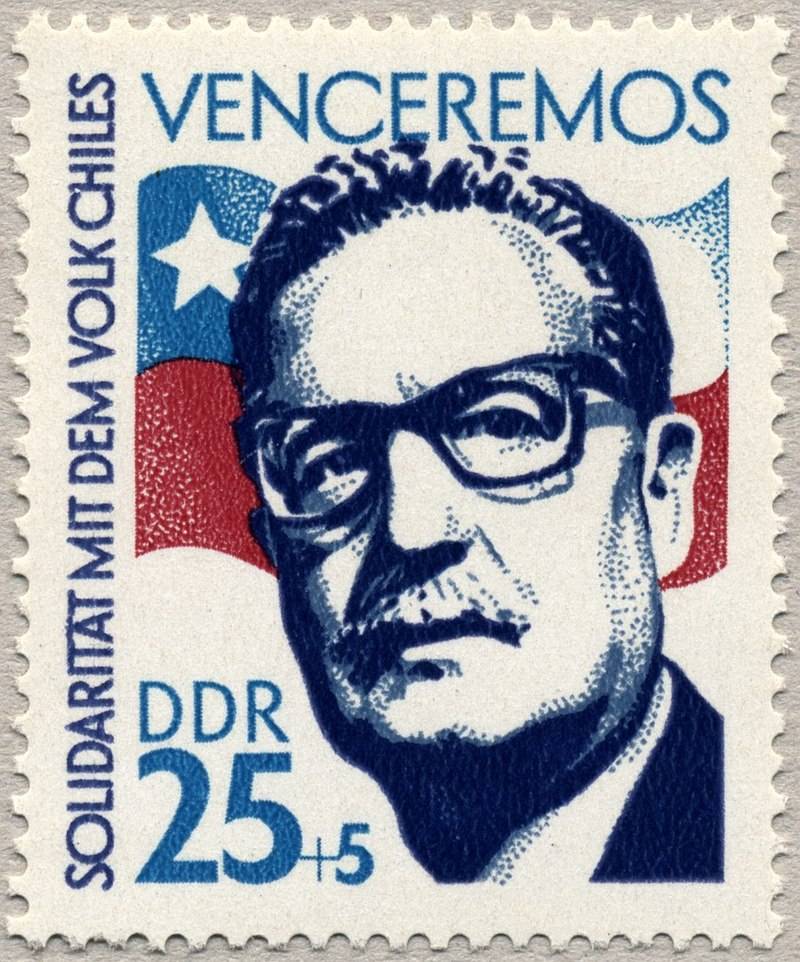
Stamp of the GDR with a portrait of S. Allende
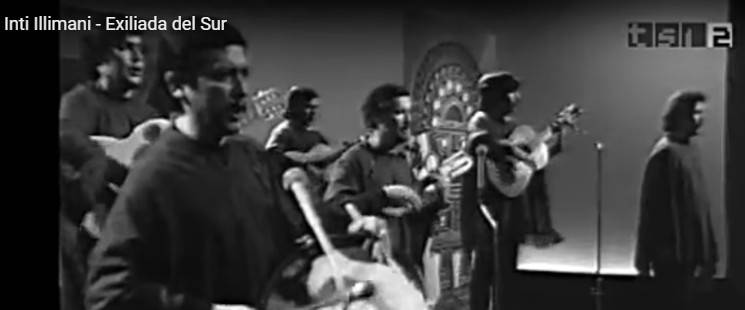
Group "Inti-Illimani" (Illimani is the name of the mountain, literally translated into Russian, its name means "Golden Eagle")
With such "trump cards in hand" it was even possible to "sit down to play" with the leaders of the Goskino USSR: by banning such an "ideologically consistent" film, it was easy to please the "accomplices of world imperialism" as well. The Soviet film directors had to “close their eyes” to the episodes of the second part of this picture, shocking with their cruel naturalism.
In 2008, the rock opera The Star and Death of Joaquin Murieta was also staged by the Alexei Rybnikov Theater (A. L. Rybnikov State Creative Workshop). The premiere performances were shown on November 27-30 in the Mir Concert Hall, the leading roles were played by S. Svetikova and D. Koldun, and I. Sandler, who starred in Grammatikov's film as one of Murieta's enemies, tried himself in the role of Death. One of these performances was attended by the French couturier Pierre Cardin, a big fan of Juno and Avos, another famous opera by A. Rybnikov.
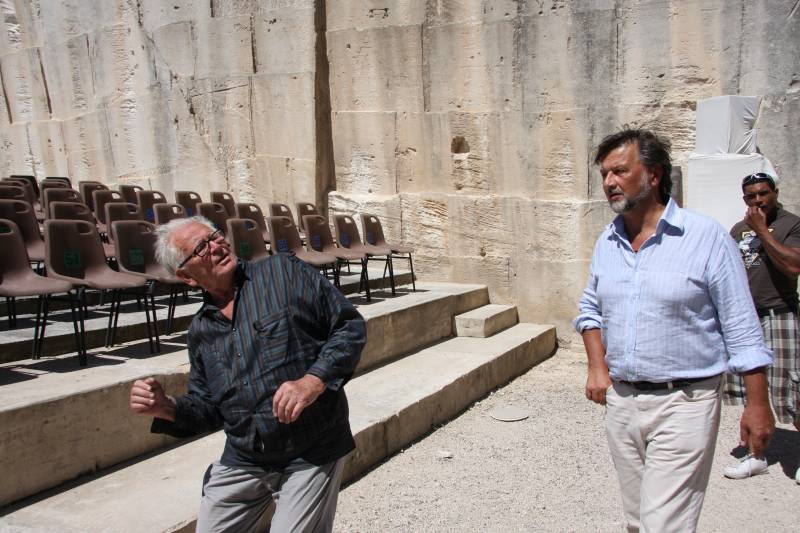
Alexey Rybnikov and Pierre Cardin in the couturier's theater, arranged in a former quarry, France, Lacoste, Marquis de Sade castle, 2008
And then the audience saw a new version of the play about Joaquin Murieta. The reason was the exorbitant financial claims of P. Grushko, who moved to the USA, who demanded completely unrealistic money for the use of the theater by A. Rybnikov with his texts. Having been refused, he went to court, but lost the case. Meanwhile, this conflict was the reason for the revision of the opera in the direction of greater reliability. Joaquin again (as expected) became a Mexican, his wife regained the name Rosita. Instead of Death, a new character appeared. A. Rybnikov said:
The performance was called "Joaquin Murieta". The new texts of the arias were written by Yuli Kim, who had known the composer since the filming of the film "Treasure Island" (it was released in 1971), and further cooperation was continued on the filming of the movie fairy tale "About Little Red Riding Hood". Julius Kim spoke about his work in the following way:
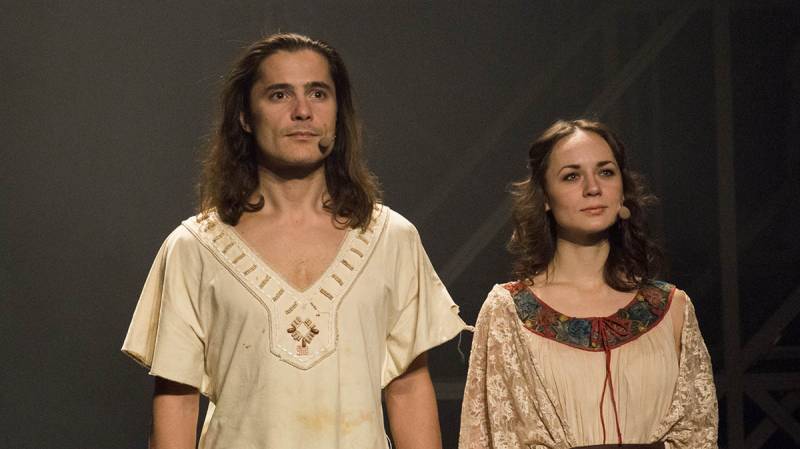
Joaquin and Rosita performed by P. Zibrov and M. Savina on the stage of the Alexei Rybnikov Theater
The level of new poems, perhaps, turned out to be higher than in Grushko's version, and most importantly, the characters began to act more logically, and the action, in comparison with Grammatikov's film, lost not only part of the pathos, but also the caricature vulgarity of some episodes. So, in the Soviet film, the gold diggers' saloon, apparently, was supposed to illustrate the thesis about the "rotten essence of social relations in a capitalist society." The defiantly vulgar performance of the local "actresses" was then parodied in the comedy "The Man from the Capuchin Boulevard." And in the film “Spirit of Sonora” by A. Rybnikov, filmed according to the new version of the play, the girls entertaining the miners look much more decent - while maintaining all the attributes of a cheap variety show for an undemanding public. "Saloon girls" from Grammatikov's film are clearly and unequivocally defined by the audience as "ladies of easy virtue." In The Spirit of Sonora, the audience saw a troupe of not-too-lucky professional dancers and singers who, due to various circumstances, are forced to earn a living by performing for the rough prospectors of wild California.
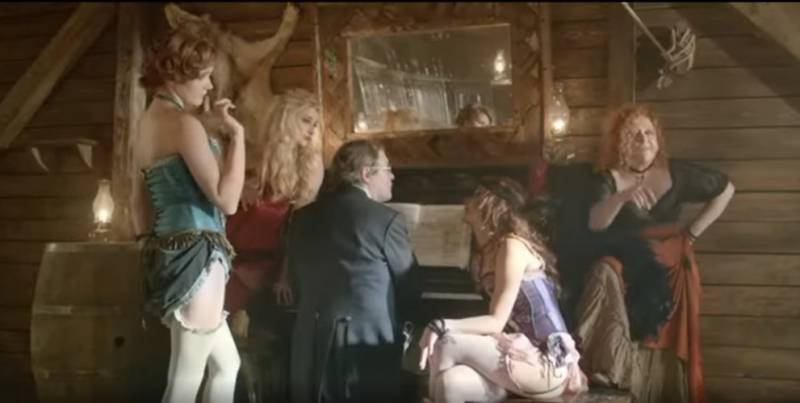
Frame from the film "Spirit of Sonora"
One of these “light genre” actresses gets a job (appears with a letter of recommendation) right before the performance:
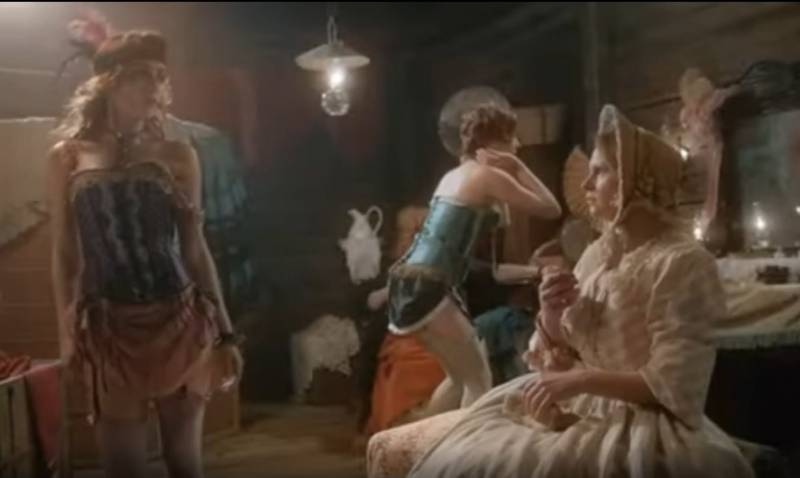
And after about half a minute we see the stage image of this, quite recently such a modest and seemingly inconspicuous girl:
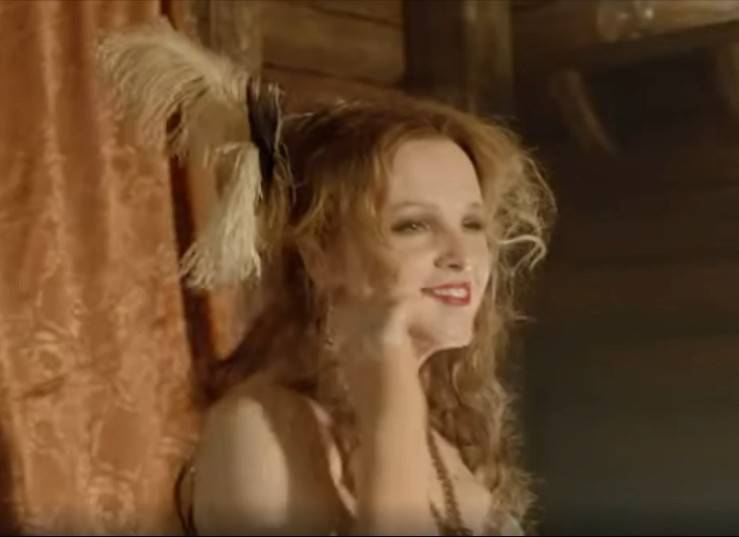
And it was not at all the obsessive harassment of one of these girls to Joaquin that provoked a bloody quarrel between the Mexicans and the Anglo-Saxons.
On the other hand, the main hit of this opera, Rosita's aria, now sounds more organically: the heroine simply talks about her feelings for Joaquin. The well-known aria of the Star in the perfect and unsurpassed performance of Zhanna Rozhdestvenskaya is without a doubt one of the best musical numbers of the entire XNUMXth century. But it has nothing to do with the action of the play - it is an absolutely independent and self-sufficient work. "Star" after all, as we remember from first article, in Neruda's original cantata, this is not a character at all, but Fulqor, an epithet referring to Joaquín Murieta: his "radiance", or "brilliance", even "magnificence". And therefore A. Rybnikov was absolutely right, combining the images of the Star and Teresa in the new version of his opera and transferring to the Mexican sorcerer the parts of another non-existent character - Death, which in the title of Neruda's "dramatic cantata" is simply death (as a biological process). By the way, it was also easy to do without this sorcerer, but it was a pity to refuse already written and very good musical fragments.
In 2015, the film "Spirit of Sonora" was filmed. Composer Alexei Rybnikov in this case acted as the author of the script, director and general producer.
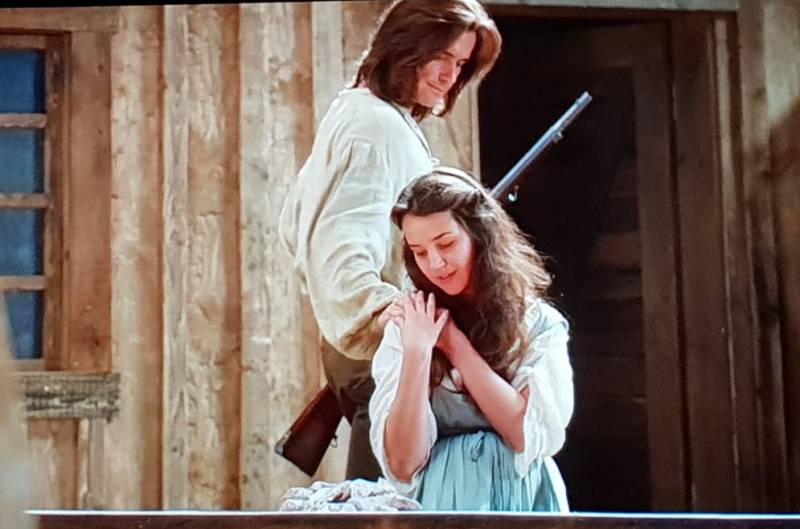
P. Zibrov and L. Khasanova in the film "Spirit of Sonora"
Sketch and implementation:
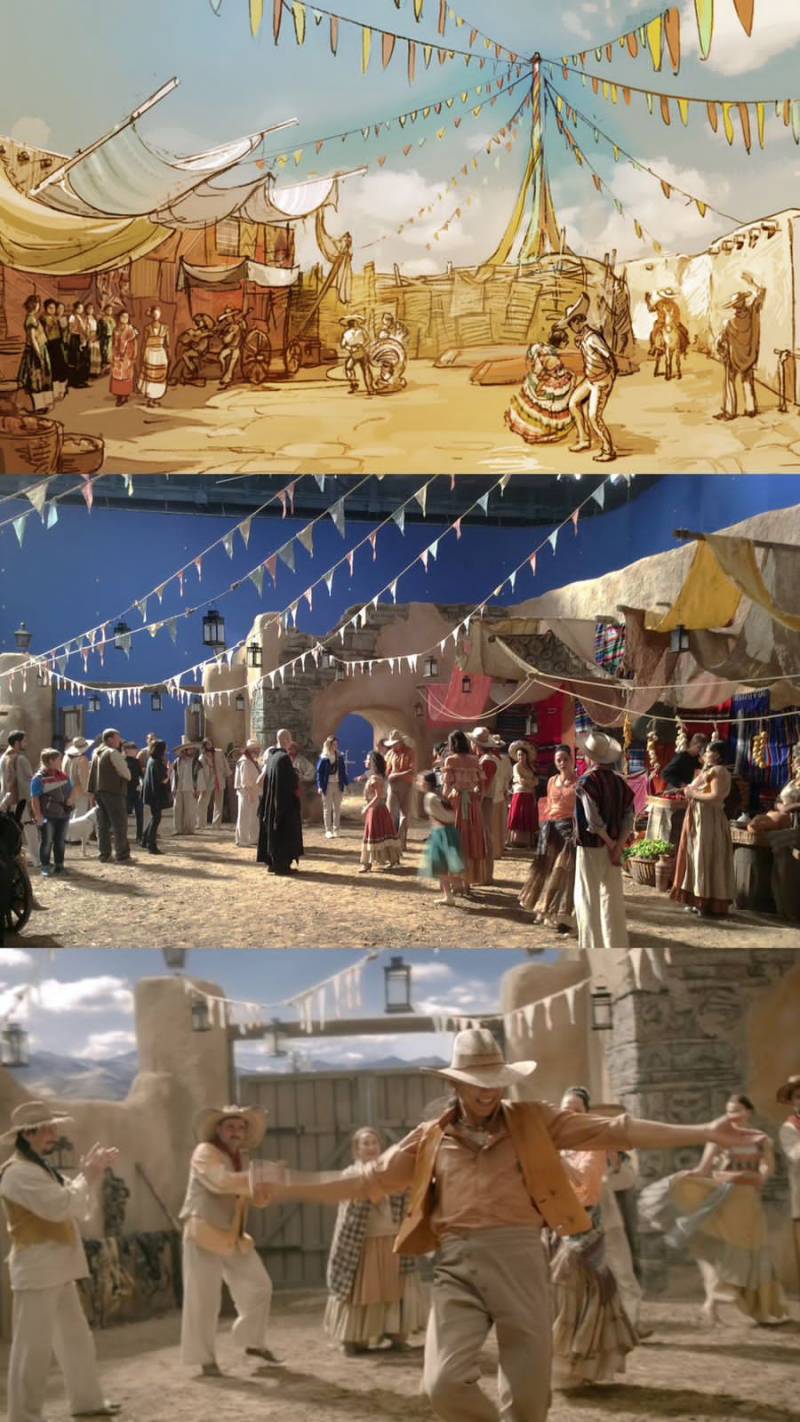
This film is unusual in that the actors really "live" sang on the set. Filming took place in the pavilions of Mosfilm, where the square of the Mexican city, the ship, the saloon of gold diggers and other scenery were built. The premiere was planned to take place in October 2017 at the film festival in the Mexican city of Oaxaca, but it was canceled due to the earthquake. As a result, the world premiere took place on November 11 of the same year in New Delhi as part of the Days of Russian Cinema in India festival. And in 2019, this film was shown in Berlin and Cannes. While maintaining the drama and tragedy, this film turned out to be much less cruel compared to the Soviet one. The scenes of violence in The Spirit of Sonora are less naturalistic and more theatrical. Since they are, in essence, only illustrating the musical theme, they take up much less screen time - exactly as much as the soundtrack lasts.
“Spirit of Sonora” is, first of all, a musical film, for its full-fledged display with high-quality sound reproduction, equipment of a very high level is required. Such an opportunity has now appeared in the Gradsky Hall Theater and Concert Association, whose artistic director is A. L. Rybnikov. In 2022, a huge black screen was purchased from the German company Gerreits, which is now used to create light paintings and video installations. It greatly expanded the possibilities of the site.

A photograph illustrating the possibilities of the screen of the Gradsky Hall theater stage: Bonaparte's coronation, a scene from the play Le prince Andre. Prince Andrei Bolkonsky" (October 21, 2022)
That is why it was decided to stage a fundamentally new theatrical performance in this theater with the participation of rock musicians and vocalists who will accompany the screening of the film "Spirit of Sonora" with live music. Aleksey Rybnikov has not yet revealed all the secrets, the premiere is planned for the end of the 2022-2023 theatrical season.
Information